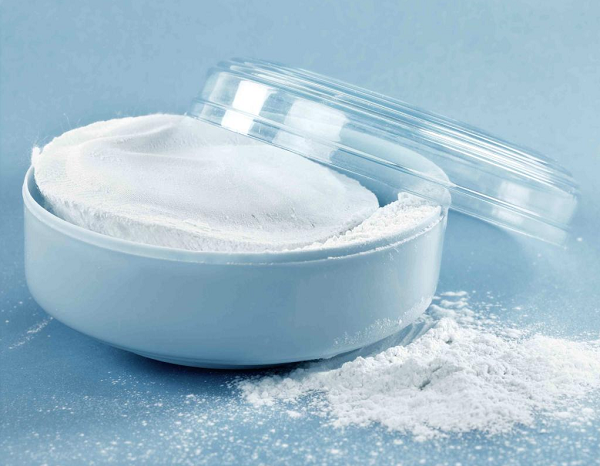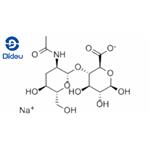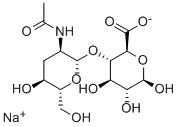Sodium hyaluronate:Synthesis, Physical Form, and Toxicity
Mar 4,2024
Description
Sodium hyaluronate, also known as hyaluronic acid sodium and hyaluronate sodium, is the sodium salt of hyaluronic acid. Sodium hyaluronate is a derivative of hyaluronic acid. It has many uses, including treating arthritis, dry eyes, ulcers, and wounds. It is also present in skin care products and cosmetics.
Synthesis
Like Hyaluronic Acid, Sodium Hyaluronate can be derived from animal tissues (e.g., rooster combs) or microbial fermentation[1]. Sodium Hyaluronate manufactured for food use was reported to be manufactured via fermentation using the bacterial strain Streptococcus equi subsp. zooepidemicus. This process begins with preparing a seed broth from seed culture, which is transferred to a fermenter containing a sterilized fermentation medium. Following fermentation, the broth is mixed with ethanol. The crude Sodium Hyaluronate precipitate is dissolved in water and filtered to remove impurities and inactivated fragments. The resulting filtrate is precipitated, dehydrated, and dried, yielding the final product.
Physical Form

Sodium hyaluronate is supplied as a white fiber-like or creamy white powder with a very faint odor. It usually contains not less than 98% of the salt, although some products have lower levels. It usually does not lose more than 10% of its weight on drying and typically gives no more than 20% of residue on incineration. A 0.2% water solution of sodium hyaluronate can have a pH range of 5.5 to 7.5. During the purification of sodium hyaluronate, which involves the removal of lipids, proteins, and nucleic acids, its molecular weight quickly drops. Sodium hyaluronate dissolves slowly but completely in water to give a clear, faintly opalescent, colorless, and highly viscous solution. The salt is soluble in sodium chloride solution but almost insoluble in organic solvents. Up to 90% of the salt can be insoluble in ethanol. In addition, aqueous solutions of sodium hyaluronate must be preserved, using 0.4% to 0.75% phenoxyethanol, for example, as the material is a rich source of nutrients for microbes[2].
Toxicity
The cytotoxicity of hyaluronan-based hydrogels to vascular smooth muscle cells harvested from the thoracic aorta of Sprague-Dawley rats was assessed. Sodium hyaluronate was dissolved in Dulbecco’s Modified Eagle Medium (DMEM) to form a 1% viscous mixture to form HyA. Dextrantetramethyl-rhodamine and dextran were mixed in a 0.04% (w/w) ratio (dex-rhod/dextran) to form Dex 15-rhod. HyA was incorporated into a 20% solution of methacryloyl-dex in DMEM with photoinitiators to form Dex 15-HyA. HyA was combined with methacryloyl in an aqueous environment, and then glycidyl methacrylate (GMA) was added to the solution for a theoretical substitution of HyA60. The resulting powder was dissolved in DMEM to form a 1% (w/v) free-radical photopolymerized solution to form HyA60. The solutions/gels were in indirect contact with rat cells with nutrient supplements for 48 hours. Cells exposed to HyA60 were significantly less viable than cells from the control groups. None of the other solutions/gels had toxic effects.
Several reproductive and developmental studies on subcutaneously injected Hyaluronic Acid (up to 60 mg/kg/d) and Sodium Hyaluronate (up to 50 mg/kg/d) were performed in rats and rabbits. In most assays, treatment with the test substance did not affect mortality, necropsy observations post-delivery, food or water consumption, or fertility in dams. However, in one assay in which rats were given up to 60 mg/kg bw of a 1% Hyaluronic Acid solution in physiological saline via subcutaneous injection, nodular hyperplasia of reticular zone cells was present in the adrenal glands of treated animals. No severe fetal abnormalities were observed in rats or rabbits.
References
[1] Bagchi, M. et al. “Selected herbal supplements and nutraceuticals.”Reproductive and Developmental Toxicology (2011): 385-393.
[2] Lillian C Becker. “Final report of the safety assessment of hyaluronic acid, potassium hyaluronate, and sodium hyaluronate.” International Journal of Toxicology 28 4 Suppl (2009): 5–67.
- Related articles
- Related Qustion
- What is Sodium hyaluronate used for? Dec 27, 2023
Sodium hyaluronate (NaHA) is a derivative of hyaluronic acid. It has a wide range of uses in medicine, skin care and cosmetics. skin care and cosmetics.
- Sodium Hyaluronate in Skin Care: Benefits, Side Effects and Preparation Apr 7, 2023
Sodium hyaluronate is an ingredient that's extracted from hyaluronic acid. It’s the sodium salt form of hyaluronic acid.
- What is Sodium Hyaluronate? Aug 17, 2021
Sodium hyaluronic acid (Hyaluronic Acid, HA), also known as sodium hyaluronate, is a kind of natural macromolecule linear mucopolysaccharide formed by repeatedly connecting D-glucuronic acid and N-acetylglucosamine as disaccharide units.
Supplementation with pyridoxal 5'-phosphate monohydrate can synthesize neurotransmitters such as dopamine and serotonin, maintaining a healthy nervous system.....
Nov 4,2025Biochemical EngineeringWhen it comes to gluten-free baking, you may come across the question of whether to use Xanthan Gum or Guar Gum.....
Mar 4,2024Biochemical EngineeringSodium hyaluronate
9067-32-7You may like
Sodium hyaluronate manufacturers
- Sodium hyaluronate
-

- $0.00 / 25KG
- 2025-12-05
- CAS:9067-32-7
- Min. Order: 1KG
- Purity: 98
- Supply Ability: 10000KGS
- Sodium hyaluronate
-

- 2025-12-05
- CAS:9067-32-7
- Min. Order:
- Purity: 0.99
- Supply Ability:
- Sodium hyaluronate
-

- $0.00 / 1kg
- 2025-12-05
- CAS:9067-32-7
- Min. Order: 1kg
- Purity: 95%-105%; food grade, cosmetic grade, eye-drop grade and injection grade
- Supply Ability: 100kg






